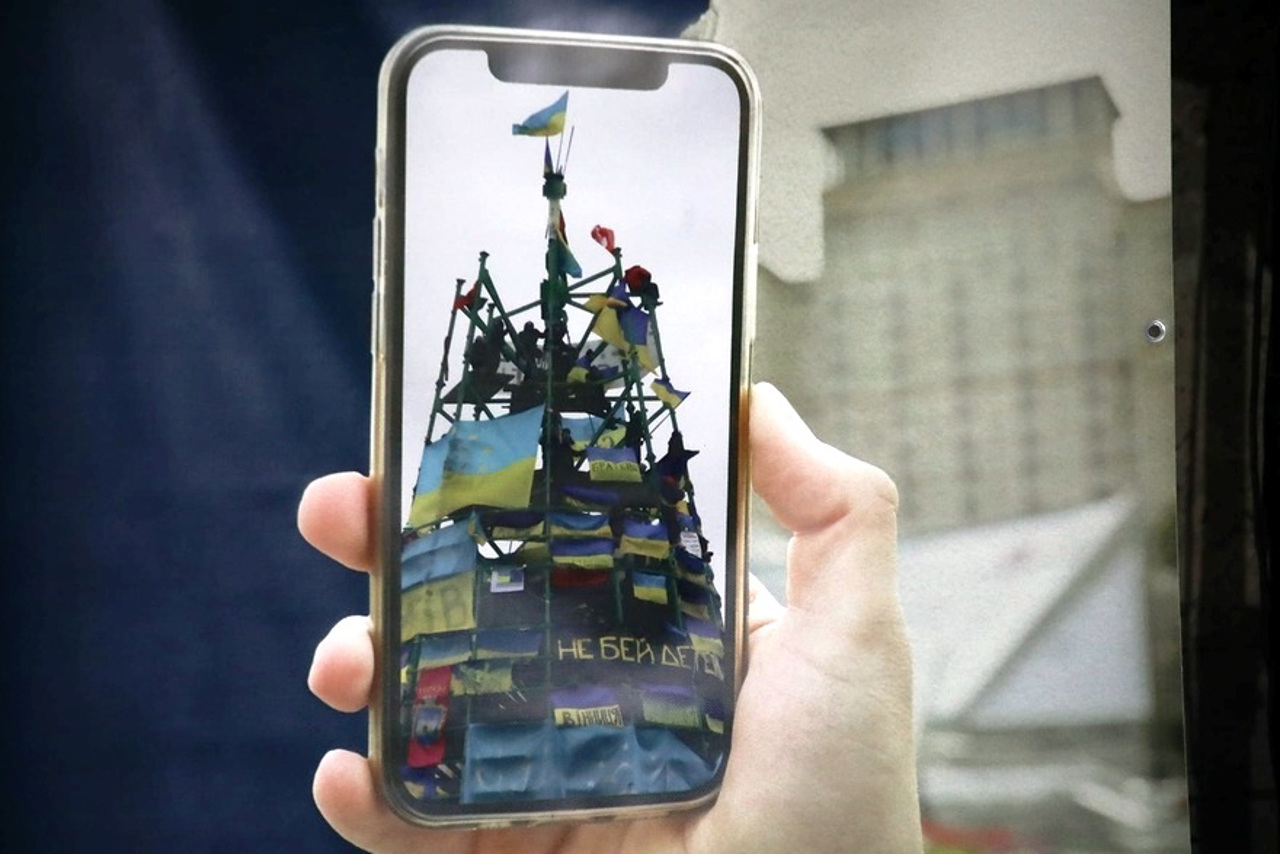Thanks to the project "Territory of Dignity in Augmented Reality: Museification of Maidan Monuments", everyone will be able to see the 10 most famous objects of the Revolution of Dignity in Augmented Reality.
As noted during the presentation, the project "Terra Dignitas AR: museification of the sights of the Maidan" is the first attempt to "revive" the Kyiv Maidan of 2013-2014 by means of augmented reality.
In the center of Kyiv, with the help of a smartphone, anyone who wants to can learn more about the Revolution of Dignity and see the 10 most famous revolutionary objects in augmented reality: these are barricades, elements of a tent city, the structure of "Yolka", etc.
"This project is not just our desire to reproduce these objects, but it is also a component of our monument protection activities. All these objects are part of history. We are working to ensure that the locations of the Revolution of Dignity are properly preserved. We had discussions about how they should be presented. This project is probably the best way to show and preserve these places", - emphasized the curator and author of the project Olha Salo.
Acting Minister of Culture and Information Policy Rostyslav Karandyeyev noted that the Maidan was the first event that marked the beginning of Ukraine's powerful, unfortunately bloody resistance to modern Russian aggression.
"There are many people who bear the memory of this event, but thanks to the project, they will be able to remember how it really was. The issue of national memory is very important. Maidan is a great historical culture. He started the next stage of our national liberation from the Russian yoke and imperial influence," said Karandeev.
He emphasized that this project was created not even for contemporaries, but for children and grandchildren who will draw inspiration for their further achievements.
Based on the materials collected by the National Museum of the Revolution of Dignity, the shape, proportions, and appearance of each object have been reproduced. There is also an opportunity to view three-dimensional models of everyday life and protection of Maidan citizens.
"It was necessary to collect a huge photo base that is in the museum's funds, to look through it, to choose the most expressive objects that are there, so that a project could be made based on them. As a result, we processed about 15,000 photos," informed project manager Anastasia Haydukevych-Kachuro.
The executive director of the ADVIN company, which is a partner of the project, Artem Chygyrynskyi noted that all modern consumers of information, in particular children, actually live in two worlds - physical and digital.
"It is important to unite these two worlds from the point of view of information perception. Augmented virtual reality technologies help to do this. These technologies help, for example, to immerse yourself and see 3D images in real size and shape through a phone," added Chygyrynskyi.
Source: Ukrinform
Як зазначалося під час презентації, проєкт "Terra Dignitas AR": музеєфікація пам’яток Майдану" є першою спробою “оживити” київський Майдан 2013–2014 років засобами доповненої реальності.
У центрі Києва за допомогою смартфона всі охочі зможуть більше дізнатися про Революцію Гідності та побачити 10 найвідоміших революційних об’єктів у доповненій реальності: це барикади, елементи наметового містечка, конструкція "Йолки" тощо.
“Цей проєкт є не просто нашим бажанням відтворити ці об'єкти, а це також складова нашої пам'яткоохоронної діяльності. Всі ці об'єкти є складовою історії. Ми працюємо над тим, щоб локації Революції Гідності були належним чином збережені. У нас точилися дискусії щодо того, як вони мають бути представлені. Цей проєкт, мабуть, найкращий спосіб показати і зберегти ці місця”, - підкреслила кураторка й авторка проєкту Ольга Сало.
Виконуючий обов'язки міністра культури та інформаційної політики Ростислав Карандєєв зазначив, що Майдан був першою подією, яка стала початком потужного, на жаль, кровопролитного опору України сучасній російській агресії.
“Є дуже багато людей, які є носіями пам'яті про цю подію, але зможуть завдяки проєкту згадати, як же воно було насправді. Дуже важливим є питання національної пам'яті. Майдан є великою історичною культурою. Він почав черговий етап нашого національного визволення від російського ярма і імперського впливу”, - сказав Карандєєв.
Він підкреслив, що цей проєкт створений навіть не для сучасників, а для дітей та онуків, які будуть черпати натхнення для своїх подальших звитяг.
На основі матеріалів, зібраних Національним музеєм Революції Гідності, відтворено форму, пропорції, вигляд кожного об’єкта. Також є можливість оглянути тривимірні моделі елементів побуту та захисту майданівців.
“Треба було зібрати величезну фотобазу, яка є у фондах музею, передивитися, вибрати найбільш промовисті об'єкти, які там є, щоб на основі їх можна було зробити проєкт. У результаті ми обробили близько 15 тисяч фотографій”, - поінформувала керівниця проєкту Анастасія Гайдукевич-Качуро.
Виконавчий директор компанії ADVIN, яка є партнером проєкту, Артем Чигиринський зауважив, що всі сучасні споживачі інформації, зокрема діти, живуть фактично у двох світах - фізичному і цифровому.
“Важливо об'єднати ці два світи з точки зору сприйняття інформації. Це допомагають зробити технології доповненої віртуальної реальності. Ці технології допомагають через, наприклад, телефон зануритися і подивитися 3D образи в реальному розмірі та формі”, - додав Чигиринський
Джерело: Укрінформ



